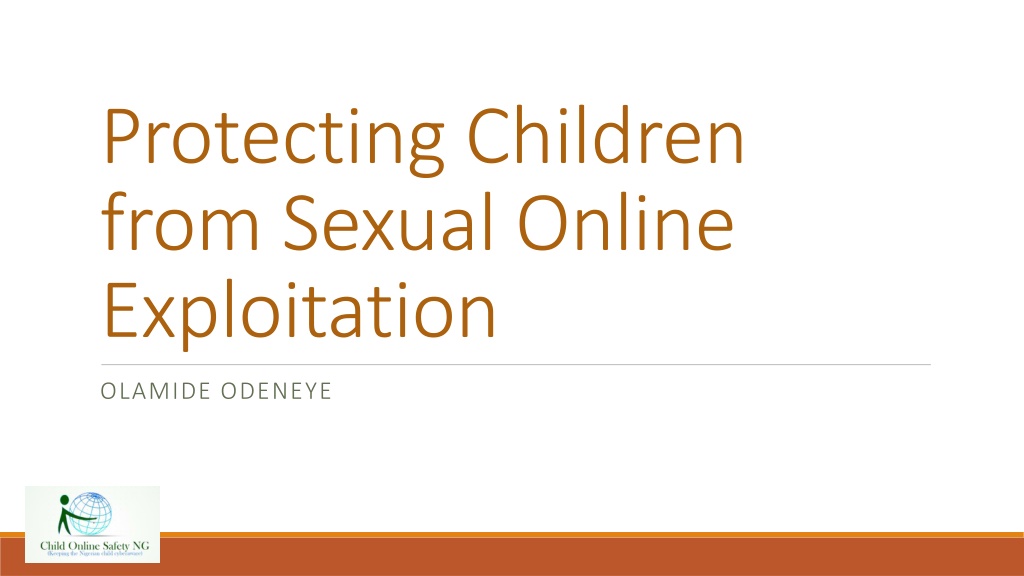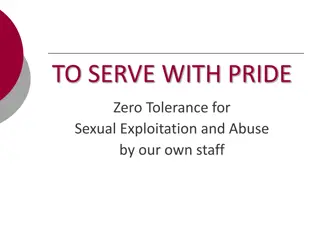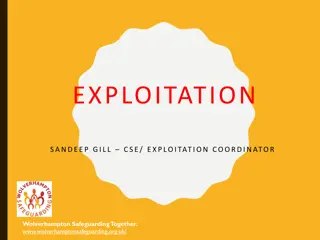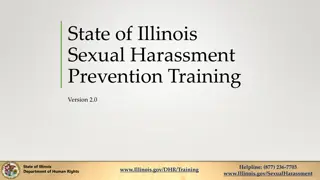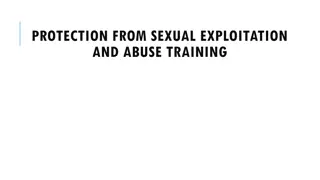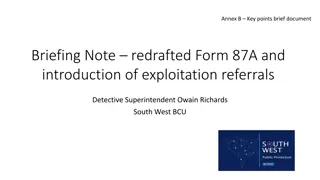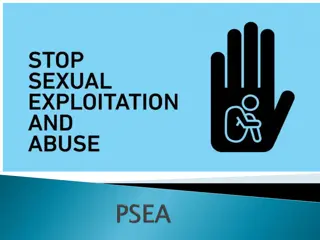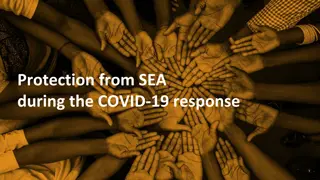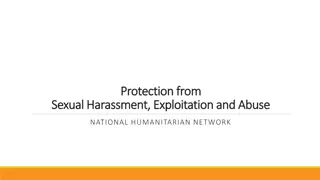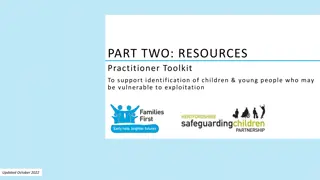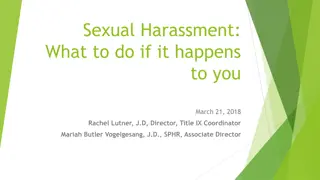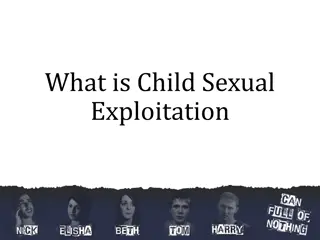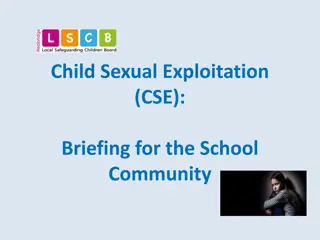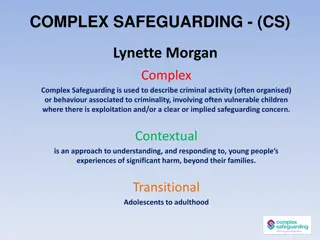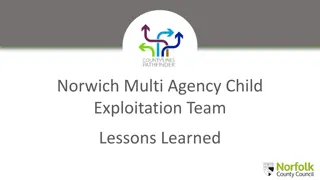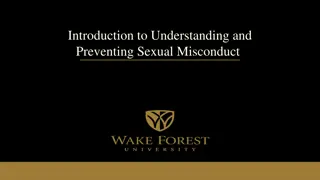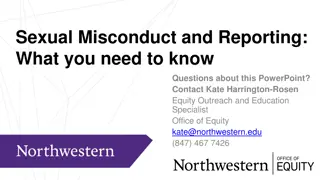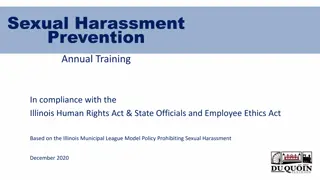Protecting Children from Sexual Online Exploitation: Understanding the Threat
Child sexual exploitation is a form of abuse where offenders exploit their power over children, both in person and online. This abuse can take various forms such as cyber molestation, grooming, sextortion, and sexting. It is crucial to educate children, parents, and caregivers about the risks and signs of online exploitation to prevent harm and protect the youth from falling victim to such heinous acts.
Download Presentation

Please find below an Image/Link to download the presentation.
The content on the website is provided AS IS for your information and personal use only. It may not be sold, licensed, or shared on other websites without obtaining consent from the author. Download presentation by click this link. If you encounter any issues during the download, it is possible that the publisher has removed the file from their server.
E N D
Presentation Transcript
Protecting Children from Sexual Online Exploitation OLAMIDE ODENEYE
What is Child Sexual Exploitation Child sexual exploitation is a form of sexual abuse where offenders use their power, (physical, financial or emotional) over a child or young person, or a false identity, to sexually or emotionally abuse them. Sexual exploitation is a real threat for children and young people of all ages and backgrounds. It often involves situations and relationships where young people receive something (food, accommodation, drugs, alcohol, cigarettes, affection, gifts, money etc.) in return for participating in sexual activities. Child sexual exploitation can occur in person or online, and sometimes the child or young person may not even realise they are a victim. 1 in 4 girls experirnce some form of sexual violence 1 in 10 boys before they reach the age of 18 88% of children know their abusers ( cece yara foundation)
Some CSE acts. Online child abuse is a unique form of child abuse also known as Cyber Molestation due to its virtual, distanced, and anonymous nature. Such abuse may not happen face-to-face, nor does it necessarily require physical contact. However, online abuse can result in negative face-to-face consequences in the form of statutory rape, forcible sexual assault, harassment, etc Grooming occurs when an adult uses electronic communication (including social media) in a predatory fashion to try to lower a child s inhibitions, or heighten their curiosity regarding sex, with the aim of eventually meeting them in person for the purposes of sexual activity. This can include online chats, sexting, and other interactions. Life streaming of child sexual abuse in real time occurs when a child is forced to appear in front of a webcam to engage in sexual behavior or subjected to sexual abuse Sextortion is a serious crime that occurs when someone threatens to distribute your private and sensitive material if you don't provide them images of a sexual nature, sexual favors, or money.
Major threats continued Sexting refers to the process by which someone intentionally shares sexually explicit messages, images or self-generated sexualised images of themselves. These images or videos are often shared with other peers. There are also many cases of "unwanted sexting". This refers to the non-consensual aspects of the activity, such as lack of consent in sharing or receiving sexually explicit photos or messages. Computer/ digitally generated child sexual abuse/exploitation material The term "computer (or digitally) generated child sexual abuse material" encompasses all forms of material representing children involved in sexual activities and/or in a sexualised manner, with the particularity that the material does not depict a real child, but rather an artificially created child, using digital tools. It includes what is sometimes referred to as "virtual child pornography". Child sexual abuse material Child sexual abuse material (CSAM), the preferred term of choice to "child pornography", refers to the materials depicting acts of sexual abuse and/or focusing on the genitalia of the child. The term "child sexual exploitation material" (CSEM) can be used in a broader sense to encompass all other sexualised material depicting children.4 These materials include children of all ages, boys and girls and differ in level of severity of the abuse and acts ranging from children posing sexually to gross assault.
The role of the internet Anonymity, as well as very limited regulation, enables exploiters to easily come into contact with potential victims. The increasing use of social media has also allowed for more opportunities for people to come into contact with offenders and has enabled offenders to anonymously interact with an increasing number of potential victims. Not only has the pool of potential victims expanded exponentially, so too has the pool of potential opportunistic offenders. The internet is becoming an increasingly dangerous place for children and teenagers whose online profiles often attract aggressive sexual predators. Personal information posted online can lead to abductions and sexual exploitation of children Molesters are finding new ways and new opportunities to NETWORK with each other on how to exploit children In many countries, legislation, law enforcement, and awareness have failed to keep up with the negative impacts of the internet and the challenges it brings. In others, the threat has not yet been prioritized or there are limited resources to invest in infrastructure or safeguards to protect children and vulnerable adults online.
How they operate Online Molesters use internet venues popular with children and adolescents ( such friendly websites/apps like Facebook, Instagram, Snapchat, MySpace, Whatsapp, Gaming apps are often used by sexual predators as victim directories) using instant communications such as instant messaging, email and chat rooms They use information PUBLICLY divulged in online profiles and social networking sites to identify potential targets. They contact victims, using deception to cover up their ages and sexual intentions. Then they entice unknowing victims into meetings or stalk and abduct them
Prevention: How do we make that possible Creating a trusting environment within the home( Become the trusted Adult) Use of Parental controls which includes supervision/monitoring How to create safe, secure passwords How to protect online privacy When to share and not share personal information How to post photography responsibly How to protect against viruses, malware, phishing, ransom ware and identity theft Ways to keep online activity professional ( no to risky behavior,visiting xrated sites, chatting about sexual related content) Understanding the permanence of an online presence
More. Don t post or respond to anything when you are emotionally charged up Do secure your profile Don t tell the world where you are at all times Do regularly search for yourself online, just to see what is out there Be careful about oversharing Don t hang out with the wrong crowd online and be very careful about taking online relationships offline. Do properly set up the privacy settings and preferences with the social media apps, sites and software you use
Why is Cyber Safety so important? Cyber safety is an important set of guidelines/rules/ideas to follow when interacting with people or websites on a computer, typically through the internet. When you use the internet you are making connections to strangers, as well as their servers, so it is extremely important to understand the risks of online behaviour. If you are not careful you can very easily end up having your identity stolen, your credit ruined/, and your files gone forever.
It is OUR COLLECTIVE RESPONSIBILITY No single state can prevent and combat online child sexual exploitation and abuse alone. Students/children need to be empowered with the knowledge ,skills and confidence to learn with digital tools at school, at home , at work and in their communities. ICT transforms how students think and offers them greater flexibility over how ,where and when they learn. Teachers , along with families play an important role in preparing students by bringing a greater understanding and awareness of safe online behaviors
Wanna know more https://www.equalitynow.org/tech_sexual_exploitationwww.ecpat.or www.ecpat.org https://assets.publishing.service.gov.uk/government/uploads/system/uploads/attachment_data/file/ 591903/CSE_Guidance_Core_Document_13.02.2017.pdf https://www.leics.police.uk/kayleighslovestory#:~:text=In%20the%20early%20hours%20of,for%20gro oming%20and%20false%20imprisonment. https://resourcecentre.savethechildren.net/keyword/child-sexual-exploitation?page=1 https://www.proceduresonline.com/swcpp/cornwall_scilly/p_ch_sexual_exploit.html#online_cse https://www.unicef.org/media/66776/file/Guide-for-Religious-Leaders-and-Communities-ENG.pdf https://www.proceduresonline.com/swcpp/cornwall_scilly/p_ch_sexual_exploit.html#online_cse
